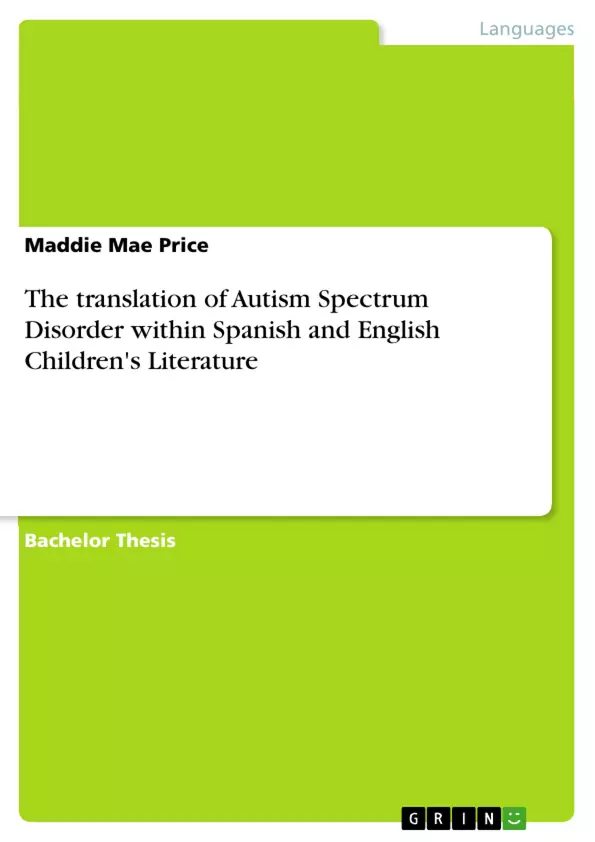
The translation of Autism Spectrum Disorder within Spanish and English Children's Literature
Bachelorarbeit, 2024
45 Seiten, Note: 1st Class
Leseprobe
Table of Contents
- Abstract
- Introduction
- Literature Review
- Writing Children's ASD literature
- Linguistic and Cultural Barriers
- Translation Methods and Approaches
- ASD in Translation and Cultural Perceptions
- ASD Representation in Literature
- The Importance of Illustration
- Methodology
- Analysis
- Culturally Specific Contexts and Items
- Inclusive and Accessible Language
- Illustration and Intersemiotic Translation
- Discussion
- Aspects of the Translation Process
- Improving the Forward-Back Translation Model
Objectives and Key Themes
This dissertation aims to analyze children's literature about Autism Spectrum Disorder (ASD) in translation, focusing on how cultural context is reframed for target readers. It critically examines translation approaches for accuracy and highlights the need for non-verbal descriptions in literature for individuals with ASD. The study evaluates the success of cultural and linguistic aspects in existing translations and explores the function of autism-related literature for children.
- Cultural Adaptation in Translation of ASD Literature
- Linguistic and Accessibility Needs for Neurodivergent Readers
- The Role of Illustration in Communicating ASD Narratives
- Evaluation of Existing Translation Models for ASD Literature
- Proposal for an Improved Translation Model
Chapter Summaries
Introduction: This introductory chapter sets the stage for the dissertation, highlighting the underrepresentation of ASD in children's literature, particularly in translation. It establishes the research gap concerning the accessibility of translated materials about ASD for neurodivergent children and introduces the dissertation's primary objective: to analyze existing translations and propose improvements for future works. The chapter emphasizes the importance of culturally sensitive and linguistically accessible translations that cater to the specific needs of the target audience, including the crucial role of non-verbal cues often necessary for comprehension by autistic children.
Literature Review: This chapter reviews existing literature on writing children's literature about ASD, focusing on the linguistic and cultural barriers encountered during the translation process. It examines various translation methods and approaches, exploring their suitability for ASD-themed texts. A key focus is on how ASD is represented in literature across different cultures and the significant role of illustrations in enhancing comprehension for autistic children. The review lays the foundation for the dissertation's methodology and analysis by establishing a theoretical framework for understanding the challenges and opportunities involved in translating this specific genre of literature.
Methodology: This chapter outlines the research methodology employed in the dissertation. It details the selection criteria for the analyzed texts (both source and target texts in Spanish and English), specifying the chosen children's books about ASD and explaining the rationale behind their selection. The chapter explicitly describes the analytical approach used, referencing House's Functional-Pragmatic Model (2009) as the primary framework for comparative analysis of source and target texts. The methodologies used for assessing cultural adaptation, linguistic accessibility, and the intersemiotic translation of illustrations are clearly explained, setting the stage for the detailed analysis that follows.
Analysis: This chapter presents a detailed analysis of the selected children's books, focusing on culturally specific contexts and items, inclusive and accessible language use, and the role of illustration in conveying meaning. Each aspect is examined thoroughly, with specific examples drawn from the source and target texts. The analysis employs House's model to compare the source and target texts, highlighting areas of successful and unsuccessful translation in relation to the needs of the neurodivergent audience. The chapter provides a rich empirical basis for the discussions and conclusions that follow.
Discussion: This chapter discusses the findings from the analysis chapter, focusing on the aspects of the translation process that proved most crucial for effective communication with neurodivergent readers. It highlights the strengths and weaknesses of the chosen translation approaches and uses the evidence gathered to propose a refined version of the Forward-Back Translation Model, specifically tailored to the unique needs of translating literature about ASD. This section offers practical recommendations for future translations, emphasizing the importance of inclusivity, accessibility, and accuracy in representing information about ASD.
Keywords
Autism Spectrum Disorder (ASD), Children's Literature, Translation Studies, Cross-Cultural Communication, Neurodiversity, Inclusive Language, Accessible Translation, Intersemiotic Translation, Illustration, House's Functional-Pragmatic Model, Forward-Back Translation Model, Cultural Adaptation, Linguistic Accessibility.
Frequently asked questions
What is the purpose of this document?
This document provides a comprehensive language preview of a study analyzing children's literature about Autism Spectrum Disorder (ASD) in translation. It includes the title, table of contents, objectives and key themes, chapter summaries, and keywords, intended for academic use in analyzing themes in a structured manner.
What topics are covered in the table of contents?
The table of contents outlines the structure of the study, including sections on the abstract, introduction, literature review (covering writing children's ASD literature, linguistic and cultural barriers, translation methods and approaches, and ASD in translation and cultural perceptions), methodology, analysis (focusing on culturally specific contexts, inclusive language, and illustration), discussion, and conclusion.
What are the main objectives of the study?
The study aims to analyze children's literature about ASD in translation, focusing on how cultural context is reframed for target readers. It examines translation approaches for accuracy and highlights the need for non-verbal descriptions. It also evaluates cultural and linguistic aspects in existing translations and explores the function of autism-related literature for children.
What are the key themes explored in the study?
The key themes include cultural adaptation in translation of ASD literature, linguistic and accessibility needs for neurodivergent readers, the role of illustration, evaluation of existing translation models, and a proposal for an improved translation model.
What does the introduction chapter cover?
The introduction sets the stage for the dissertation, highlighting the underrepresentation of ASD in children's literature, particularly in translation. It establishes the research gap concerning the accessibility of translated materials and introduces the dissertation's primary objective: to analyze existing translations and propose improvements.
What does the literature review chapter cover?
The literature review examines existing literature on writing children's literature about ASD, linguistic and cultural barriers, translation methods, and the representation of ASD across different cultures. It also explores the role of illustrations in enhancing comprehension for autistic children.
What methodology is used in the study?
The study employs House's Functional-Pragmatic Model (2009) as the primary framework for comparative analysis of source and target texts. The selection criteria for texts, the analytical approach, and methods for assessing cultural adaptation, linguistic accessibility, and intersemiotic translation are detailed.
What is analyzed in the analysis chapter?
The analysis chapter focuses on culturally specific contexts and items, inclusive and accessible language use, and the role of illustration in conveying meaning. Specific examples are drawn from source and target texts, and House's model is used to compare the texts.
What is discussed in the discussion chapter?
The discussion chapter analyzes the findings from the analysis chapter, focusing on the aspects of the translation process that proved most crucial for effective communication with neurodivergent readers. It also proposes a refined version of the Forward-Back Translation Model.
What are the keywords associated with this study?
The keywords include Autism Spectrum Disorder (ASD), Children's Literature, Translation Studies, Cross-Cultural Communication, Neurodiversity, Inclusive Language, Accessible Translation, Intersemiotic Translation, Illustration, House's Functional-Pragmatic Model, Forward-Back Translation Model, Cultural Adaptation, and Linguistic Accessibility.
Details
- Titel
- The translation of Autism Spectrum Disorder within Spanish and English Children's Literature
- Hochschule
- University of Newcastle upon Tyne (School of Modern Languages )
- Veranstaltung
- Modern Languages, Translation and Interpreting
- Note
- 1st Class
- Autor
- Maddie Mae Price (Autor:in)
- Erscheinungsjahr
- 2024
- Seiten
- 45
- Katalognummer
- V1576060
- ISBN (Buch)
- 9783389127483
- Sprache
- Englisch
- Schlagworte
- Translation autism English spanish language linguistics neurodivergence SEN literature children's literature UK Spain special needs additional needs diversity inclusion equality
- Produktsicherheit
- GRIN Publishing GmbH
- Preis (Ebook)
- US$ 21,99
- Preis (Book)
- US$ 31,99
- Arbeit zitieren
- Maddie Mae Price (Autor:in), 2024, The translation of Autism Spectrum Disorder within Spanish and English Children's Literature, München, Page::Imprint:: GRINVerlagOHG, https://www.diplomarbeiten24.de/document/1576060
- Autor werden
- Ihre Optionen
- Vertriebskanäle
- Premium Services
- Autorenprofil
- Textarten und Formate
- Services für Verlage, Hochschulen, Unternehmen

- © GRIN Publishing GmbH.
- Alle Inhalte urheberrechtlich geschützt. Kopieren und verbreiten untersagt.
- info@grin.com
- AGB
- Open Publishing
Der GRIN Verlag hat sich seit 1998 auf die Veröffentlichung akademischer eBooks und Bücher spezialisiert. Der GRIN Verlag steht damit als erstes Unternehmen für User Generated Quality Content. Die Verlagsseiten GRIN.com, Hausarbeiten.de und Diplomarbeiten24 bieten für Hochschullehrer, Absolventen und Studenten die ideale Plattform, wissenschaftliche Texte wie Hausarbeiten, Referate, Bachelorarbeiten, Masterarbeiten, Diplomarbeiten, Dissertationen und wissenschaftliche Aufsätze einem breiten Publikum zu präsentieren.
Kostenfreie Veröffentlichung: Hausarbeit, Bachelorarbeit, Diplomarbeit, Dissertation, Masterarbeit, Interpretation oder Referat jetzt veröffentlichen!
- GRIN Verlag GmbH
-
- Nymphenburger Str. 86
- 80636
- Munich, Deutschland
- +49 89-550559-0
- +49 89-550559-10
- info@grin.com
-









